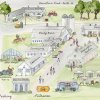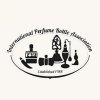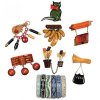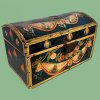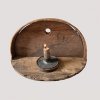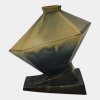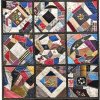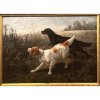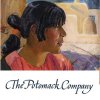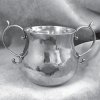$1.6 Million Decoy and Sporting Art Auction
July 25th, 2015
|
The Anthony Elmer Crowell preening wood duck was the highlight of the auction and realized $210,000.
Albert Elmer Crowell’s miniature green heron, 4 1/4" x 5 1/4" pictured left, carved around 1930, was estimated at $1000/1500 and brought $5100. His miniature bluebill drake is at 1 1/8" x 2 1/8" one of the smallest Crowell carvings known. It sold on the phone for $1020. Copley Fine Art photo.
This Crowell miniature preening pintail drake from about 1920 is considered rare, as the carver made few preening miniatures. With minimal wear and touch-up to the tip of the tail, it went for $28,800, well in excess of the $10,000/15,000 estimate, to the same phone bidder who bought the Lincoln miniatures.
Nathan Cobb’s running curlew drew $52,800.
Art collector and author Adele Earnest prized this running sickle-billed decoy, 20½" long, that has it all, form and a finely painted surface. It sold for $36,000. It was carved on Cape Cod around 1880. Copley Fine Art photo.
This feeding brant by Nathan Cobb, Jr., from about 1880, sold for $52,800.
This pair of black ducks, one preening and the other swimming, from about 1910, were carved by Townsend Garvie Carman (1874-1938) of Amityville, Long Island, New York, and sold for $15,600. Copley Fine Art photo.
This hissing Canada goose carved around 1920 by Ira Desanko Hudson (1873-1949) of Chincoteague, Virginia, sold for $21,600. In his prime Hudson charged $4 per dozen of his carved birds.
Arthur Burdett Frost (1851-1928) led the fine art as his 1895 watercolor and gouache English Snipe, 14" x 21½", brought $48,000. The picture is the original of the one published in Shooting Pictures, the 1895 publication of his work by Charles Scribner’s Sons. Copley Fine Art photo.
German-American artist Edmund Henry Osthaus (1858-1928) loved dogs, especially those at work, as seen in Three Setters, a 19" x 27" watercolor that sold for $13,200. |
Copley Fine Art Auctions, Plymouth, Massachusetts
Like the birds they come in pursuit of, collectors and dealers flock to Copley Fine Art Auctions’ summer decoys sale. Decoy auctions are, in tandem with the buying and selling of sporting art, lively social events, largely fraternal reunions where collectors and dealers catch up with old friends, exchange news and information about carvers, and generally have a good time. Collectors and collector/dealers prize the careful art of the carved bird. Many view the birds as pure art, folk art. Some of the birds that come across the block are old friends, and they move from collection to collection. The day before the July 25 auction in Plymouth, Massachusetts, 40 prospective members showed up for a meeting that was called to revive the New England Decoy Collectors Association. That revival is in the works.
Attendees clustered three and four deep at the dealer exhibitions open later in the afternoon on July 24, and buying and selling was brisk. Within the exhibition space was another event—an exhibition and sale of new works by the McNairs, Mark, Ian, and Colin. A fillip to the day was the demonstration of the fine art of carving by Mark and Ian McNair. Spectators were spellbound as they watched a bird emerge from a block of cedar. (Colin McNair was attending to business. He is the decoy specialist at Copley Fine Art.) Meanwhile the bar was open, and hors d’oeuvres circulated freely against a background of live music. And that was just the preview.
The sale itself was 85% sold and brought $1.6 million.
It took no time at all for auctioneer Peter Coccoluto to get to lot 28, the Anthony Elmer Crowell (1862-1952) preening black duck for which everyone was waiting. Bidding opened at $170,000, and it was over in seconds when the bird realized $210,000 (includes buyer’s premium) with a $200,000/300,000 estimate. The 15" x 6¼" x 6½" bird, carved around 1900, predated Crowell’s brand. It came from a private collection, was well published, and had been exhibited at the Shelburne Museum in 1961. Black ducks were Crowell’s most requested ducks. Most of them were carved in straight-head configurations, while preening examples, such as this example, are rare. The buyer was Rye, New Hampshire, dealer Russ Goldberger for a client.
Crowell, of East Harwich, Massachusetts, is a magical name in the decoy world, and his carvings are justifiably prized. Stephen B. O’Brien Jr., president of Copley Fine Art, described how the canny Crowell, early in his career, devised a live decoy method of luring
wildfowl. He raised the birds, clipped their wings, and set them out. He even rigged up a highly effective system whereby the live birds would set out from a flap—like an automatic garage door opener—on a pulley. Crowell taught his system to other hunters, and as a noticeable decrease in wildfowl population became evident, the government stepped in and banned the use of live decoys. Crowell started carving in earnest.
Crowell’s running black-bellied plover is considered one of his finest plovers. The bird “runs” on a clamshell, which bears Crowell’s crisp oval brand and dates the bird to around 1912 when he purchased the oval brand. Estimated at $30,000/50,000, it garnered $78,000 from a phone bidder. The bird sold for $26,290 at Christie’s January 2003 sale of the Russell Barnett Aitken collection. It came most recently from an unidentified private collection.
A collection of 22 Crowell miniature songbirds and ducks brought robust results. The quality was better than is usually seen. The birds were purchased from Crowell by the original owner, in whose family they descended. A Crowell miniature canvasback hen, 3 3/8" x 4", dated from about 1930 and retained the carver’s rectangular stamp on the bottom. It sold for $5400 to the same phone bidder who paid $2040 for a miniature cedar waxwing, 2 5/8" x 3 1/8", from about 1930. A miniature Wilson’s common tern, 2¼" x 4¼", sold online for $2760, while a miniature goldfinch, 2¼" x 2¾", with the rectangular stamp, sold on the phone for $1800.
A miniature pintail drake from about 1910 and from another collection retained the rare “A.E. Crowell, M’FR, East Harwich” round ink stamp, marking it as an early carving. With original paint and minimal wear, it realized $2880 on the phone.
Crowell’s circa 1930 life-size semipalmated plover mantel carving went to a phone buyer for $21,600, and his circa 1915 running yellowlegs with painted tack eyes brought $27,600.
Birds carved by Joseph W. Lincoln (1859-1938) of Accord, Massachusetts, are highly prized. His miniature carvings brought respectable but not ostentatious prices. A miniature sleeping Canada goose, 4 7/8" long, was $4500 (est. $2000/3000); a miniature swimming Canada goose, 6¼" long, was $4200; and a 4¾" long Canada goose was $3300. They were all pictured in the 2004 Decoys Unlimited sale catalog, and they all went to the same phone bidder.
A black duck from about 1920 carved by Charles Hart (1862-1960) of Gloucester, Massachusetts, was highly detailed and sold for $12,000, twice the high estimate.
A graceful looking long-tailed duck drake carved around 1952 by Lemuel T. Ward (1896-1984) of Crisfield, Maryland, was signed and dated and is considered rare. The “SGH” stamp on the bottom denotes the Somers G. Headley collection from which it came. It sold on the phone for $11,400.
Nathan Cobb, Jr., (1825-1905) of Cobb Island, Virginia, carved an 18¾" long feeding brant, circa 1880, with a “root head,” probably of southern wax myrtle, with German glass eyes. It bore an incised “E” and an “E.B. Cobb” brand denoting it as part of guide Elkanah B. Cobb’s (Nathan’s son) gunning rig. The bird was well published and drew $52,800. A Nathan Cobb, Jr., running curlew with an oak beak and black glass eyes bore the carver’s large “N” and also brought $52,800. Both birds were well documented, and their provenance was exceptional. Cobb’s black-bellied plover from about 1880 bore an incised “A” for Cobb’s brother Albert, and its provenance included William J. Mackey and William H. Purnell, Jr. The bird sold on the phone within estimates for $14,400.
Chincoteague, Virginia, carver Ira D. Hudson (1873-1949) carved a pintail drake around 1930 that spurred a bidding competition. Opening at $9500, the beautifully painted bird sold for $38,400. It came from the collection of William H. Purnell, Jr. Hudson’s hissing Canada goose, circa 1920, with tack eyes and detailed carving to the bill sold for $21,600.
Not only did Craddockville, Virginia, carver Mark S. McNair (b. 1950) demonstrate the art of carving, he exhibited his birds, some of which found new homes. Some of his carvings were also in the auction. A white sperm whale, circa 2000, 11" x 50" x 2", with a carved eye, bone teeth, and a sculptural tail, realized $8400. McNair’s circa 1990 preening whistling swan fetched $7200. His hollow wood duck drake, circa 2005, retained the original paint and showed some wear. It brought $4200.
Adele Earnest, an early decoy collector and the author of The Art of the Decoy: American Bird Carvings (1965) was one of six founding trustees of the American Folk Art Museum, and it was she who elevated the consideration of decoys as folk art. Birds from her collection are highly desirable. Her favorite decoy was a running sickle-billed curlew made on Cape Cod around 1880 that featured in her book and came from a subsequent private collection. With an “Adele Earnest Collection” stamp and the mark “K,” it doubled the high estimate when it sold for $36,000. An early yellowlegs, circa 1860, from Earnest’s collection had a metal bill and a metal stickup rod and realized $4500.
A rigmate pair of mallards with uplifted heads by Astoria, Oregon, carver Charles Pice (1890-1945), in the original and distinctive paint, sold for $13,200 (est. $3000/5000).
 Three miniature snowshoes, 6¾" x 2 1/8" x ¼", circa 1910 and thought to have been made in New England, possibly by Native Americans, were the subject of much presale interest. Everyone wanted to see them, but not everyone wanted to buy the shoes that were thought to be salesmen’s samples. They sold below the $200/300 estimate for $120. A 10½" tall pair of penguins with applied heads and incised raised wings were also much admired, and they sold for $9600 (est. $2000/3000). A pair of canvasback ducks by Randy Tull (b. 1947) of Hayward, Wisconsin, was estimated at $400/600 and sold for $3300.
Three miniature snowshoes, 6¾" x 2 1/8" x ¼", circa 1910 and thought to have been made in New England, possibly by Native Americans, were the subject of much presale interest. Everyone wanted to see them, but not everyone wanted to buy the shoes that were thought to be salesmen’s samples. They sold below the $200/300 estimate for $120. A 10½" tall pair of penguins with applied heads and incised raised wings were also much admired, and they sold for $9600 (est. $2000/3000). A pair of canvasback ducks by Randy Tull (b. 1947) of Hayward, Wisconsin, was estimated at $400/600 and sold for $3300.
A Massachusetts turned-head Canada goose, circa 1890, from the desirable T. Gray rig, in original paint, was published extensively and had fine provenance. At $20,400, it went just above the low estimate.
It was also Ogden Minton Pleissner’s day in the salesroom. His watercolor Upland Bird Shooting, 17¾" x 28", came from a Virginia collection and brought $33,000. Pleissner’s watercolor The Gorge—Salmon Fishing, 17" x 27½", finished at $30,000, the low estimate. Pleissner’s 1940 12" x 16" oil on board Ross Lake, a Wyoming view, sold for $15,600 against the $6000/9000 estimate.
Woodcock Hunting, a 19" x 29¼" watercolor by Aiden Lassell Ripley (1896-1969), sold below estimate for $24,000, but his 1917 watercolor Grouse in Grapes, 18" x 25", from the estate of Anne C. Allen, brought $9600, just below the high estimate, as did Canada Goose Shooting, a 17" x 29" watercolor.
For more information, call (617) 536-0030 or check the website (www.copleyart.com).
Originally published in the October 2015 issue of Maine Antique Digest. © 2015 Maine Antique Digest





